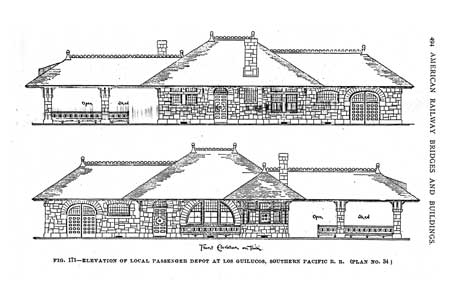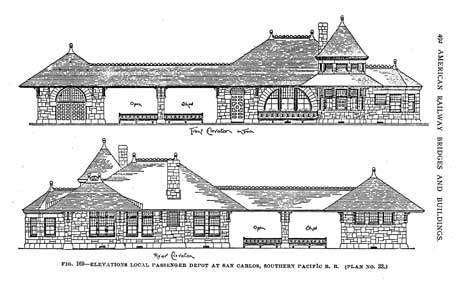
History of the Depot
Discovering Our Sister Station
Doug Offenbacher
From the beginning of this series, we’ve talked about our “twin” depot in San Carlos. It was an early discovery that turned up while researching the architectural style of our depot, Richardsonian Romanesque.
We discussed how the two depots, drawn by the same hand, had been conceived, designed and constructed simultaneously, each as the centerpiece for a new village – railroad towns along promising Central Pacific corridors.
Ours, Los Guilicos, was to be the crown jewel of the Sonoma Valley line connecting Santa Rosa to Benicia and the world beyond the Sierra. Here in idyllic Los Guilicos, there would be a race to buy vacation home sites and an eventual commerce center served by and benefitting the railroad.
To the south, on Bayside property situated midway between San Francisco and San Jose, a virtual carbon copy (remember those?) of Los Guilicos was also underway. A rail line connecting the two major cities would assure the new village of San Carlos a flood of interest from business owners seeking home sites close to but far from the urban centers.
 |
Drawings courtesy of American Railroad Buildings and Bridges. The Kenwood Depot (above) and its “twin” depot in San Carlos (below) share many of the same design features. |
 |
Column 6 [Nov. 15, 2012] dealt with this “Tale of Two Depots” in some detail. With this column we begin to learn more about our sister station in San Carlos.
Not unlike twins separated at birth, each with no knowledge of the other, the separation of time and distance has left these two remarkable structures isolated and their relationship virtually forgotten. Historians in San Carlos had no idea our depot even existed – but this is the year of rejoining.
Save the date of September 28 for a very special birthday party at the Depot. It will be 125 years since these two historic siblings went into service. Be there for the official reuniting of two sisters long separated. Several special guests as well as representatives from the San Carlos History Museum will be here to celebrate with us – and we are all invited to celebrate in San Carlos with them in October.
The San Carlos Depot is now owned by Caltrans and, while not a functioning depot, it does serve as a waiting area for commuters using the trains that still roll busily by. A very different environment than our rural, trackless Kenwood.
The drawings here are from American Railroad Buildings and Bridges, an industry publication issued in 1898. They appeared on consecutive pages with floor plans and were referred to as the ideal small depot design. They share three sections: a covered outdoor waiting area, a large indoor waiting room and a baggage room. These components are rearranged to better fit each site but the design, construction, detailing and all other aspects are identical. Next column you’ll see why the term “twin” is so easily applied.
In all of California railroad history, there are few depot stories that have the heart-tugging potential of the one that will be unfolding over the next few months. It’s not just a building anymore.
Articles
1. A Quiet Treasure1. Kenwood Depot 125 years of stone standing strong
2. Does the Depot Have a Twin?
3. An impressive family tree
4. Tales and tangents
5. The west was young
6. Charles Allerton Coolidge
7. N.W. Griswold
8. T. J. Ludwig
9. Mark McDonald
10. Some Additions
11. Arthur Brown, Senior
12. Marketing Los Guilicos
13. Discovering Our Sister Station
14. History of the San Carlos Depot